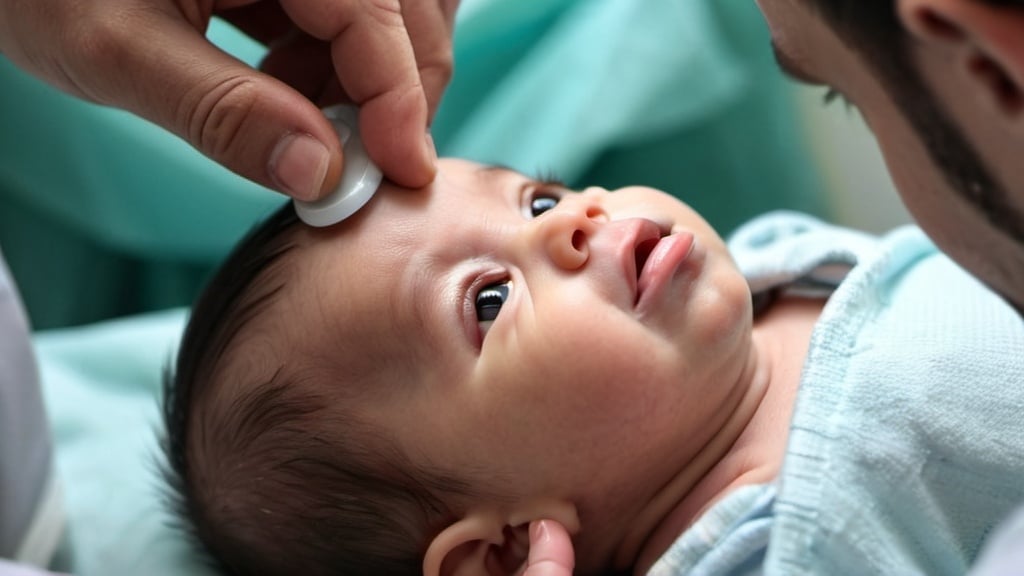1. Introduction to Newborn Circumcision
There are various techniques that can be used for newborn circumcision. Ring block (which is a good technique for its safety and analgesia) and dorsal penile block should be considered as many patients request due to the importance of analgesia. Hemostasis should be maintained during the procedure to avoid potential complications. Proper circumcision also results in a more aesthetically satisfying result. As a result, the surgical method, level of experience of the clinic and caregivers, examination of penile anatomy, appropriate medical evaluation of newborn, analgesia use, parental satisfaction, and professional and advanced wound care for after the operation may affect the postoperative outcomes of a circumcision procedure.
Newborn circumcision is a common procedure performed in male neonates worldwide. The most common indication is parental request or family tradition, however many patients request newborn circumcision for medical and sex-related hygiene reasons. The newborn period is the safest time of life for the foreskin removal, as it requires minimal time and effort. The newborn period has the least chance of anesthetic failure, serious complications, and personal memory. Furthermore, the newborn period also provides long-term clinical benefits of the procedure.
1.1. Importance and Controversies
In 1997, only 37% of newborn males born in Dutch hospitals were circumcised, but this number will paradoxically rise in the future. Increasing planning of the Muslim and Jewish populations to utilize hospitals’ newborn 1-week visits provided the factor to establish dedicated routine newborn circumcision clinics in the midst of the Netherlands. Two established independent clinics have developed comprehensive treatments using contemporary procedures, resulting in approximately 2000 safe male circumcisions performed annually, with a focus on uncomplicated term infants of any age.
While no medical association in the world recommends routine circumcision of boys, medical recommendations toward the practice are broadly supportive in the United States. At the same time, many medical organizations have questioned the financial and ethical aspects of newborn circumcision, especially during the economic downturn. Such criticism from the medical community has stimulated growing awareness of male circumcision. Ultimately, the debate will lead to team-based support and careful surgical procedures to minimize associated risks and complications, keeping them as low as possible. Providing circumcision services to the 60-70% prevalence population is a significant responsibility, and an independent clinic, free from political pressure or influence, has a significant position in this continuum of care.
2. Choosing a Newborn Circumcision Clinic
When you are choosing a newborn circumcision clinic for your baby, it is suggested that you choose a clinic with a doctor who has a broad range of knowledge and experience in the area of circumcision. It won’t just be the initial circumcision cutting that the doctor will need to do. Every baby is different in so many ways including being born with different bleeding and clotting abilities. Some infants clot quickly and others don’t. A professional, experienced clinic doctor will be able to spot any signs before beginning the procedure and be able to take whatever necessary precautions to decrease the risk of any complications. The best doctors will know how to be sensitive and aware of a baby’s physical limitations. They would know what type of crying is soulful and uncomfortable opposed to cries that are simply words of protest, generally not wanting to be restrained and not wanting to be touched.
In today’s day and age, more parents are realizing the importance of choosing the right place to have their baby circumcised. Compared with the old days where everyone would automatically circumcise their son in the hospital after birth, parents are beginning to see the value of taking their new infant to a specialized clinic for circumcision. But with the rise in popularity of infant circumcision clinics, it brings the question of which clinic to take your baby to. Here are some reasons why you should trust this comprehensive guide on newborn circumcision.
2.1. Factors to Consider
The World Health Organization, the United Nations Children’s Fund (UNICEF), and others support a comprehensive approach to male circumcision so that parents who wish to receive services have access to safe, affordable, and voluntary procedures. In areas where male circumcision is practiced, there is an increased demand for services. Local infrastructures are overwhelmed by the need for circumcision at a young age. Deaths and complications can occur if circumcisions are performed by unskilled people. These devices are available in various forms and are easy to use. They can create well-tolerated, esthetic, and precise incisions. Their use requires learning to improve the technique and is recommended in newborns and infants or a secure environment in which to perform the procedure. Providing education and resources to promote newborn health in the hospital, the community, and the family is increasing the demand for these procedures, which is a growing challenge in this field.
Parents who are considering circumcision as an elective procedure should be given information to help them understand and weigh the evidence that will probably alter their risk perception and decision-making. This information should address risk reduction, current infant anesthesia options, what is known about pain during and after the procedure, as well as procedural risks. Infant circumcision should be performed in hospitals or at sites that have the necessary requirements to handle and treat emergencies. In addition, faced with the demand for elective inpatient surgical procedures, hospitals may be able to empanel experienced surgeons in newborn circumcision in the neurological centers of the pediatric department. Providing anesthesia, analgesia, and ensuring adequate postoperative pain relief in the newborn male undergoing a medical circumcision are becoming part of the standard of care.
3. Questions to Ask Before Choosing a Clinic
– Infant circumcision: Who will perform my son’s circumcision? – How many infant circumcisions do you do a year? – Can I visit your practice? – Or how many infant circumcisions has the office performed? – We do approximately 400 infant circumcisions a year. – How do you perform a circumcision? – We do the Gomco Technique. We don’t use the Plastibell. – What is the complication rate of your technique? – Are you a current mohel at any synagogue? – Is the written consent form, including possible complications from a circumcision, signed by the parent or parents? – The signed consent form is required.
When deciding on which office to have a son circumcised, it is important to ask certain questions that will allow you to make an informed and educated decision. We offer an office tour free of charge. We urge you to visit other offices or ask these questions on the phone. The questions we suggest would include the following:
3.1. Safety and Sterilization Procedures
Resources also provide information regarding infection control protocols for clinics in a variety of healthcare settings, and regular updates provide the best means to keep up to date with current recommendations for healthcare settings, including those that only occasionally perform circumcisions. The highest standards of professional medical care must be practiced. All staff must be certified and competent at part-task training as a requirement of professional healthcare and be able to monitor and document all aspects of the circumcisions. All licensed people and clinics need to be involved in Continuous Quality Improvement (CQI) and Quality Assurance (QA) programs rather than Reactive Peer Review programs. The identified clinical preceptors (CPs) who will supervise the Circumcision Clinical Experience (CCE) at all or any potential off-site simulation laboratories are board-certified specialists trained in family medicine and conscious sedation techniques and clinical applications, among others. All circumcisions in a clinic must be conducted and documented for educational purposes. The most successful outcomes are acquired from early preceptors before requesting approval at the full Board Meeting of a personable, willing, and supportive Medical Director, of a physician whose sole work is circumcision.
The risk for blood-borne infections associated with newborn circumcision is low, primarily due to the low prevalence of such infections in the target population. Licensed, certified clinics that are in compliance with all local, state, and national recommendations further minimize this risk. All clinics must adhere to strict infection control measures. Any instrument brought into contact with the breached skin must be either a disposable single-use item or a sterilizable item that has been reprocessed according to national recommendations. Clients frequently inquire regarding infection risks presented by shared equipment at clinics, none of which should be reusable between patients, and staff must be knowledgeable of all protocols, including monitoring and documenting of sterilization and safety procedures. The wide variety of disinfection and sterilization methods available to circumcision clinics varies in effectiveness, and safe and effective equipment reprocessing is a key element of the professionalism of the clinic.
4. Aftercare and Follow-Up
Complications after newborn circumcision are uncommon, usually minor and easily managed. Warning signs that should prompt you to call your pediatrician would be severe pain or inability to void and observe the urine, an increasing amount of swelling at the surgical site, fever higher than 101.5 degrees, redness that increases and progresses up the shaft of the penis, greenish colored material on the sutures or bleeding with difficulty controlling it. Your pediatrician or the on-call pediatrician is always available to answer any of your concerns and address any questions you might have after your newborn’s circumcision.
Air exposure will allow the penis to heal with minimal inflammation. A gauze or Vaseline dressing is not necessary, as these can lead to irritation and healing issues. If your pediatrician has scheduled an appointment for a follow-up after your baby’s circumcision, be sure to make the appointment and keep it. We appreciate the opportunity to monitor the healing process and monitor for possible problems. The doctor will evaluate the penis and discuss any findings with you at that appointment. If you detect any bleeding or unusual symptoms, call your pediatrician to report them.
4.1. Post-Procedure Instructions
Many physicians have adopted the use of plastic rings instead of the skin tacking technique. Post procedure care includes cleaning the genital area with an antiseptic solution, followed by an application of petroleum-based ointment to the circumcision site. Petroleum jelly is applied to the penile glans to prevent adherence of the diaper. Although many post-operative circumcision complications seem to be technical in nature.
After the procedure is completed, the initial dressing should be kept in place for at least three to six hours. Afterward, it can be removed and the baby can be bathed if desired. Post care involves cleaning between 2 and 4 times per day with hydrogen peroxide, followed immediately with an application of petroleum-based ointment. The petroleum ointment will allow the wound surface to remain wet to aid in the healing process. Diapering should be performed using disposable diapers for the first few days to allow the ointment to remain in place on the circumcision site. The healing process generally occurs within seven to ten days.
5. Conclusion
In conclusion, the primary goal of clinicians should be to provide unbiased, accurate information to educate and counsel families about the benefits and obstacles to infant circumcision. Male circumcision is perceived to be a simple, benign, and feasible procedure. However, considerable parental anxiety can be associated and a small number of severe complications can occur. Parents should be provided with comprehensive information, including, when possible, an electronic multimedia package. We should continue to practice evidence-based medicine and thus have a comprehensive discussion with parents involving risks and benefits of circumcision. Decision-making aid to provide a better understanding of both the potential benefits and potential concerns of elective newborn male circumcision are available. Additionally, two-dimensional (2-D) and three-dimensional (3-D) models can assist counseling and education in several areas of maternal-infant health. Providing both printed and Internet resources is also essential in assisting families with obtaining reliable health information. During the first newborn visit, it is suggested to assess for uncertainty before considering circumcision as uncertainty decreased the likelihood of receiving circumcision at follow-up. While the internet is beneficial, physicians must help direct families to accurate information since several websites contain misinformation surrounding circumcision. The needs of the families and clinicians to make informed decisions on infant circumcision are substantial. We hope that the comprehensive issues outlined in this article will contribute to a beneficial dialogue building with parents.
5.1. Final Thoughts
There are also chapters dedicated to the pre-care and post-care of the circumcision. This information will assist the healthcare provider in preparing the family. Potential areas for post-care complications are highlighted. And finally, the reader will gain a thorough understanding of how the clinic operates. All of this information is not only essential for the provider of newborn circumcisions but also required paperwork is often not covered in traditional medical education programs. Medical organizations will also find it helpful due to the methods used to initiate and grow a newborn circumcision service.
Understanding Newborn Circumcision Clinics: A Comprehensive Guide is the first book of its kind. Healthcare providers preparing for their first day in a newborn circumcision clinic will find the practical information invaluable. The description of the usual items available will orient them to the physical surroundings. The step-by-step demonstration of the procedure allows the provider to visualize and understand the physical handling of the newborn. The discussion of potential problems provides the healthcare provider with background to make informed decisions regarding unusual outcomes of the procedure.
Eager to learn more? Visit us for additional details!
References:
Zhang, M., Chen, Z., Liu, X., and Liu, J. “Influencing factors of Chinese male circumcision acceptance willingness: a health belief model approach.” Current Psychology, 2024. [HTML]
Myers, A. and Earp, B. D. “What is the best age to circumcise? A medical and ethical analysis.” Bioethics, 2020. academia.edu
Adler, P. W., Van Howe, R., Wisdom, T., and Daase, F. “Is circumcision a fraud?.” Cornell JL & Pub. Pol’y, 2020. noharmm.org
Van der Merwe, A. “Penile allotransplantation for total phallic loss due to ritual circumcision: Proof of concept.” 2020. sun.ac.za
Freedman, A. L. “The Circumcision Decision.” Neonatology for Primary Care, 2020. [HTML]
Lempert, A. “Roadblocks to reforming UK guidelines on medically unnecessary penile circumcision: inconsistent safeguarding of bodily integrity.” Clinical Ethics, 2023. sagepub.com
Rao, Jian-Ming, et al. “Modified circumcision using the disposable circumcision suture device in children: a randomized controlled trial.” Urology 143 (2020): 206-211. presurgy.com
Özer, E., Bingöl, U. A., and Sav, M. A. “Multifocal Penile Epithelioid Angiomatous Nodule: A Rare Tumor of Penis.” Turkish Journal of Plastic Surgery, 2024. lww.com
Wang, X., Li, J., Hua, K., and Chen, Y. “Transvaginal natural orifice transluminal endoscopic surgery (vNOTES) hysterectomy for uterus weighing≥ 1 kg.” BMC surgery, 2020. springer.com
Bettocchi, Carlo, et al. “Male esthetic genital surgery: recommendations and gaps to be filled.” International Journal of Impotence Research 34.4 (2022): 392-403. nature.com
Keywords: understanding newborn circumcision clinics, comprehensive guide to circumcision services, infant circumcision procedures explained, what to expect at a circumcision clinic, selecting a reputable circumcision provider, safety and care in circumcision clinics, benefits and risks of newborn circumcision, parental guidance for circumcision decisions, clinic accreditation and qualifications, post-circumcision care for infants.






